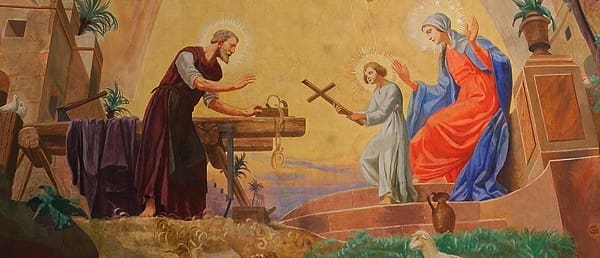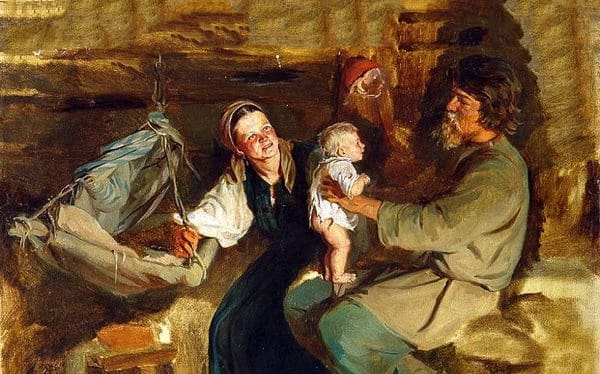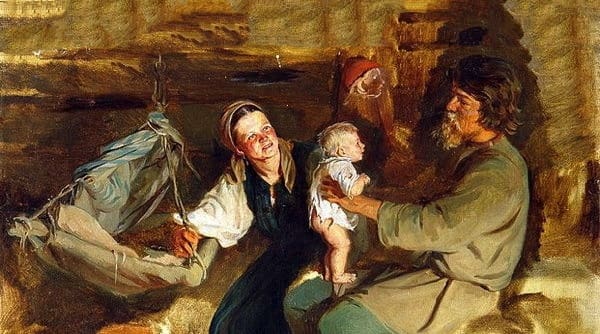The Family as Domestic Church:
How She Hands on the Faith
(Part I of IV)
Editor’s Note: As a nod to the World Meeting of Families, in this post we will look at how the family, as domestic Church, hands on the faith by living out her share of Christ’s office of priest, prophet and king, and by responding to the universal call to holiness. Today we will introduce our topic and examine how the four marks of the Church apply to the family.
The family has an essential role in the divine plan of salvation. Not only was it “willed by God in the very act of creation,”[1] Jesus himself was part of the Holy Family, “where he grew and became strong [and was] filled with wisdom,”[2] and where he sanctified it by his presence.  Scripture testifies to conversions of entire households at the beginning of Christianity,[3] not unlike what was seen in the Old Testament when Joshua said, “as for me and my household, we will serve the Lord.”[4] The baptized Christian family, then, is the initial place where Christian life is experienced, preached, heard and believed[5]. In fact, “Every marriage between Christians gives rise to a domestic church, though marriages between two Catholics most fully reflect the life of the Church, because ordinarily only Catholic couples can fully participate in the sacraments of the Church, including the Eucharist.”[6] In Baptism, we are made adopted sons and daughters in the Son and incorporated into the Church, the family of God. So, just as “The Church is…‘the family of God,”[7] the Second Vatican Council uses an ancient expression in calling the family the Ecclesia domestica, the domestic Church.[8] And, having been commissioned by God to “be living examples of Christian life,”[9] parents are, as such, the first heralds of the faith to their children.[10] For, what Saint Paul says of women applies equally to both parents. He speaks of “the various fields of the Church’s apostolic service, beginning with the ‘domestic Church’ [in which] ‘sincere faith’ passes from the mother to her children and grandchildren, as was the case in the house of Timothy (cf 2 Tim 1:5).”[11]
Scripture testifies to conversions of entire households at the beginning of Christianity,[3] not unlike what was seen in the Old Testament when Joshua said, “as for me and my household, we will serve the Lord.”[4] The baptized Christian family, then, is the initial place where Christian life is experienced, preached, heard and believed[5]. In fact, “Every marriage between Christians gives rise to a domestic church, though marriages between two Catholics most fully reflect the life of the Church, because ordinarily only Catholic couples can fully participate in the sacraments of the Church, including the Eucharist.”[6] In Baptism, we are made adopted sons and daughters in the Son and incorporated into the Church, the family of God. So, just as “The Church is…‘the family of God,”[7] the Second Vatican Council uses an ancient expression in calling the family the Ecclesia domestica, the domestic Church.[8] And, having been commissioned by God to “be living examples of Christian life,”[9] parents are, as such, the first heralds of the faith to their children.[10] For, what Saint Paul says of women applies equally to both parents. He speaks of “the various fields of the Church’s apostolic service, beginning with the ‘domestic Church’ [in which] ‘sincere faith’ passes from the mother to her children and grandchildren, as was the case in the house of Timothy (cf 2 Tim 1:5).”[11]
The Family as Domestic Church
Before looking at how the family hands on the faith, let’s consider how the family is the domestic Church. Like the Church, the family reflects the unity in diversity seen in the Trinity. As perceived by any casual observer, family members, though not clones of each other, are still part of the same family. The Christian family, like the Church, “is a communion of persons, a sign of the communion of the Father and the Son in the Holy Spirit,”[12] members in relationship with each other. She “both draws [her] sustenance from the larger communion that is the whole Body of Christ, the Church, and also reflects the life of the Church so as to provide a kind of summary of it.”[13] And, just as the Church itself is a place of grace, the family, the domestic Church, is also a place of grace where the Holy Spirit dwells, guiding her in the practice and development of the faith. “In the solemn nuptial blessing during the Rite of Marriage, the celebrant calls upon the Lord in these words: ‘Pour out upon [the married couple] the grace of the Holy Spirit so that by your love poured into their hearts they will remain faithful in the marriage covenant.”[14] Evidence of that indwelling Spirit is manifest in various ways, for example, “For young children in particular, daily family prayer is the first witness of the Church’s living memory as awakened patiently by the Holy Spirit.”[15]
The four marks of the Church can also be seen in the family as domestic Church—one, holy, catholic and apostolic:
One: The family is joined together as one unity. Like the Church, her source is in the Trinity, whose communio of Persons is reflected in the love between the parents, the gift of that unity manifested in the children, and the mutual love flowing between parents and children. Her founder is Christ, who instituted the sacrament of matrimony and lived in a family. And, her soul is the Holy Spirit who dwells within her.[16] In the same manner as the Church, the family is held together by love, which is the virtue of charity, and also by unity in faith or belief, worship or prayer, and structure.[17] As the Catechism emphasizes, “Daily prayer and the reading of the Word of God strengthen [the family] in charity.”[18]
Holy: The family is holy because Jesus was born and grew up in a family. She is holy because she is a member of his Bride, the Church, for whom Christ gave himself up so as to sanctify her.[19] The family is also holy when it does the will of God[20] and becomes part of the mystical family of God.
Catholic: The family is catholic because it is part of the universal Church. It’s a component of the parish, which is a gateway to the diocese and the universal Church. As part of the Church’s catholicity, everyone is owed the truth about God.[21] This holds true for the domestic Church, which has a particular and initial responsibility for teaching her children the truth of God.
Apostolic: It is the Lord “who…confers upon Christian married couples a special mission as apostles, sending them as workers into His vineyard, and, in a very special way, into this field of the family.”[22] The family is also apostolic having received the sacraments from the hands of priests and/or deacons who have received their commission from Christ through apostolic succession. The family manifests its apostolic character as it incarnates and lives the faith, which comes from the apostles. “Christian couples…by word and example form [their children] to a Christian and apostolic life.”[23] They prepare their children for mission, to be sent out into the world to announce the Good News by word and deed.
 But, the domestic Church is more than just the sum of the parts, or characteristics, that it shares with the Church of Christ. “If it is to achieve the full flowering of its life and mission, the married couple must practice an affectionate sharing of thought and common deliberation as well as eager cooperation as parents in the children’s upbringing,”[24] an upbringing which includes instruction in the faith. Already sharing in Christ’s mission of priest, prophet and king, Christian parents are uniquely qualified to “train their children in Christian doctrine and evangelical virtues.”[25] They do this by living out their Christian baptismal identity, and encouraging and supporting the development of their children’s baptismal identity, and teaching them to hear and respond to the call to holiness.
But, the domestic Church is more than just the sum of the parts, or characteristics, that it shares with the Church of Christ. “If it is to achieve the full flowering of its life and mission, the married couple must practice an affectionate sharing of thought and common deliberation as well as eager cooperation as parents in the children’s upbringing,”[24] an upbringing which includes instruction in the faith. Already sharing in Christ’s mission of priest, prophet and king, Christian parents are uniquely qualified to “train their children in Christian doctrine and evangelical virtues.”[25] They do this by living out their Christian baptismal identity, and encouraging and supporting the development of their children’s baptismal identity, and teaching them to hear and respond to the call to holiness.
Editor’s Note: In Part II, we will consider what being priest, prophet and king means by delving into what it means to be priest in the world and how parents carry that out within the family.
[1] John Paul II, Apostolic Exhortation, Familiaris Consortio, “The Role of the Christian Family in the Modern World (Boston: Pauline Books & Media, 1981), 3§1.
[2] Luke 2:40a.
[3] Cf Catechism of the Catholic Church: Revised in Accordance with the Official Latin Text Promulgated by Pope John Paul II. 2nd edition (Vatican City: Libreria Editrice Vaticana, 1997), paragraph 1655.
[4] Joshua 24:15.
[5] Cf Romans 10:14-15.
[6] United States Conference of Catholic Bishops, Pastoral Letter, “Marriage: Love and Life in the Divine Plan,” 2009, 6 Dec 2009 <http://www.usccb.org/laity/LoveandLife/MarriageFINAL.pdf> 119.
[9] “Rite of Marriage” The Rites of the Catholic Church as Revised by the Second Vatican Council, Volume One (Collegeville, MN: Pueblo Publishing Company, Inc., 1990) 33.
[10] Lumen Gentium: Dogmatic Constitution on the Church, Vatican Council II: The Conciliar and Post Conciliar Documents Vol. I (Northport, NY: Costello Publishing Company, Inc., 1998), 11§2.
[11] Cf John Paul II, Apostolic Letter, Mulieris Dignitatem: “On the Dignity and Vocation of Women on the Occasion of the Marian Year,” 1988, 6 Dec. 2009, <http://www.vatican.va/holy_father/john_paul_ii/apost_letters/documents/hf_jp-ii_apl_15081988_mulieris-dignitatem_en.html> 27§3.
[13] “Marriage: Love and Life in the Divine Plan” 118.
[14] John Paul II, Letter to Families, Gratissimam Sane, 1994, 10 Dec. 2009 <http://www.vatican.va/holy_father/john_paul_ii/letters/documents/hf_jp-ii_let_02021994_families_en.html> 4§3.
[17] Cf Angela Franks, “One, Holy, Catholic, Apostolic” Ecclesiology Lecture, St. John’s Seminary. Brookline, MA, 3 Nov. 2009.
[19] Cf Lumen Gentium 39.
[20] Cf Mark 3:35.
[21] Cf Franks, ibid.
[22] Familiaris Consortio 71§1.
[23] Apostolicam Actuositatem: The Decree on the Apostolate of the Laity, The Decree on the Apostolate of the Laity, Vatican Council II: The Conciliar and Post Conciliar Documents Vol. I (Northport, NY: Costello Publishing Company, Inc., 1998) 11§2.
[24] Gaudium et Spes: Pastoral Constitution on the Church in the Modern World, Vatican Council II: The Conciliar and Post Conciliar Documents Vol. I (Northport, NY: Costello Publishing Company, Inc., 1998) 52§1.
[25] Lumen Gentium 41§5.
Art: Schliengen: Saint Leodegar Church, fresco of the Holy Family, artist unlisted, Taxiarchos228 own work, 12 June 2011, Free Art License; Parental Joy, Karl (Kirill) Lemoh (1841-1910), undated, PD-US; both Wikimedia Commons.




